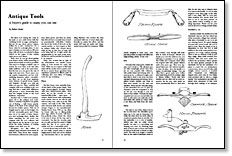
Synopsis: How do you go about getting your heart’s desire of tools while preserving as much of your bank account as possible? One way, writes Robert Sutter, is to go the antique tool route. He offers advice on how to search for old tools — how to deal with dealers and tool collectors, and how to avoid poor-quality tools. What can you expect to find in your searching and what will it cost? He answers those questions here based on his 15 years of collecting and more than 30 years of buying tools for his workshop. He covers braces, saws, adzes, drawknives, and chisels.
The latest tool catalog has come in the mail, so you settle down with the “wishing book” in eager anticipation. But my oh my, those prices: sixteen dollars for a saw, twenty-two for a brace, sixty for a plough plane. It sure puts a damper on your ardor to fill your shop with all those wonderful-looking objects in the pages of that catalog open across your knees.
Well, how do you go about getting your heart’s desire while preserving as much of your bank account as possible? One way is to budget a realistic sum of money for your basic tools and then make additions only as the need arises. Buy the best you can get in the way of edge tools and saws. If you must, you can acquire inexpensive yet less soulsatisfying hammers, pliers, screwdrivers, files, etc. at the local hardware store. Beware of special house brands and bargains, though; you only get what you pay for. Shop carefully and compare with your wishing book; you may find that a small price difference will procure a more trustworthy item than the bargain bucket at the local hardware emporium.
Another way to build your journeyman’s kit is the antique tool route. There is certainly a big kick to be gotten out of finding a half dozen peachy chisels at the back of the antique shop for just two dollars apiece. That sort of bargain may be easy on the budget, but old isn’t necessarily good, and if they turn out to be made of Swiss cheese, you can’t exchange them. Realize that when searching for old tools you compete with the tool collector and that chances are he knows a lot more about the tricky business of buying antique tools than you do.
Recognize, too, that sellers of antiques keep informed about trends in their field. They know that competition between collectors for new acquisitions raises prices, and they are aware that old tools have recently been touted as preeminently collectible. Dealers also know the worth of old tools on the current market, so don’t expect to find an antique dealer who doesn’t know what he has in that box of rusty old tools lying half out of sight under the dropleaf table in the back of the store. He knows, and he put that box where it is on purpose.
From Fine Woodworking #2
For the full article, download the PDF below:
Fine Woodworking Recommended Products

Blackwing Pencils

Circle Guide

Drafting Tools






















Log in or create an account to post a comment.
Sign up Log in